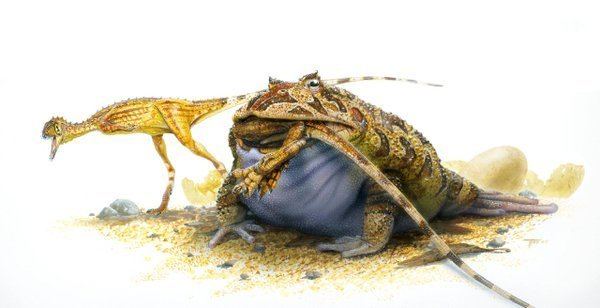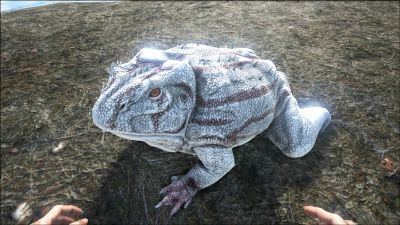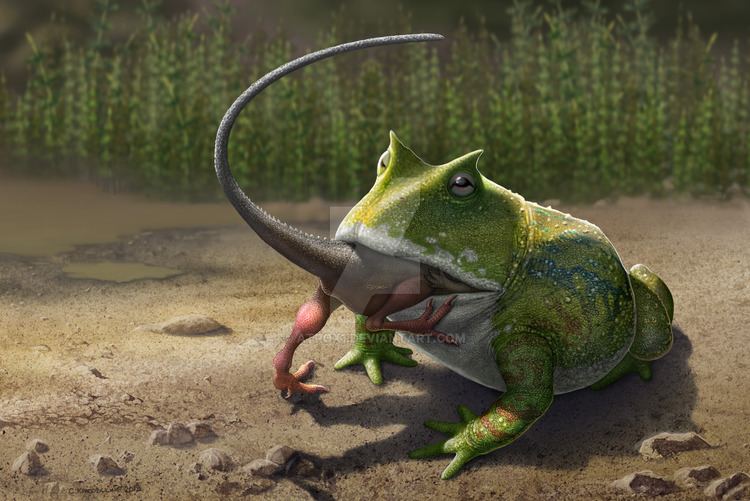Phylum Chordata Rank Species | Order Anura Scientific name Beelzebufo ampinga Higher classification Beelzebufo | |
 | ||
Genus †BeelzebufoEvans, Jones, & Krause, 2008 Similar Frog, Megaloceros, Carbonemys, Goliath frog, Amphibians | ||
Beelzebufo the devil toad
Beelzebufo ampinga (/biːˌɛlzᵻˈbjuːfoʊ æmˈpɪŋɡə/ or /ˌbiːlzəˈbjuːfoʊ/) was a particularly large species of prehistoric frog described in 2008. Common names assigned by the popular media include devil frog, devil toad, and the frog from hell.
Contents

Fossils of Beelzebufo have been recovered from strata of the Maevarano Formation in Madagascar, dating to the late Cretaceous period, some 70 million years ago (Mya).

Etymology

The generic name Beelzebufo is a portmanteau of Beelzebub (a Semitic deity whose name may be translated as "Lord of the Flies", sometimes identified either as one of the chief lieutenants, or alter ego of the Christian Devil) and bufo (Latin for "toad").
The specific name ampinga means "shield" in Malagasy.
Description

The species may have grown to 41 cm (16.1 in) and 4.5 kg (9.9 lb) — larger than any living frogs, including the largest known species, the goliath frog, which can be up to 32 cm (12.6 in). The head was big, and bones of the skull roof show a rugous external surface, indicating at least parts of the head may have borne bony scales, called scutes.

The skull sutures are open in even the biggest species of Beelzebufo, showing that it may have grown even bigger.
Biogeography
Although the fossils of Beelzebufo appear in what is now Madagascar, which, still attached to India, had split from the coast of Somalia in the earliest stage of the late Jurassic, it superficially resembles its closest living relatives, the horned toads of South America, of which the largest today grow to 15 cm (5.9 in) long.
As West Gondwana (South America) rifted away from East Gondwana, opening from the north and spreading southward, open marine conditions in the widening South Atlantic obtained by about 110 Mya, isolating the amphibians on either side; the last common ancestor of Beelzebufo and the South American Ceratophryidae is most likely to have existed before that date and probably before seafloor-spreading demonstrates the earlier isolation of Madagascar-India, a very long time undocumented by fossils.
Alternatively, the history of archaeogeography could be rewritten: Richard Lane, program director in NSF's Division of Earth Sciences, said, "The occurrence of this frog in Madagascar and its relatives' existence in South America provides strong evidence that the supercontinent Gondwana 'disassembled' during the latest part of the Cretaceous."
Lifestyle
In comparison with the living Ceratophryidae, Beelzebufo most likely was a predator whose expansive mouth allowed it to eat relatively large prey, perhaps even juvenile dinosaurs.
Discovery
The first fossil fragments were found in 1993 by David W. Krause of New York's Stony Brook University, but it took 14 years for scientists Susan E. Evans, Marc E. H. Jones, and Krause to assemble enough data for publication in the Proceedings of the National Academy of Sciences, the journal of the United States National Academy of Sciences.
Some 75 fossil fragments have been found. Researchers have been able to reconstruct parts of the frog's skeleton, including nearly the entire skull.
